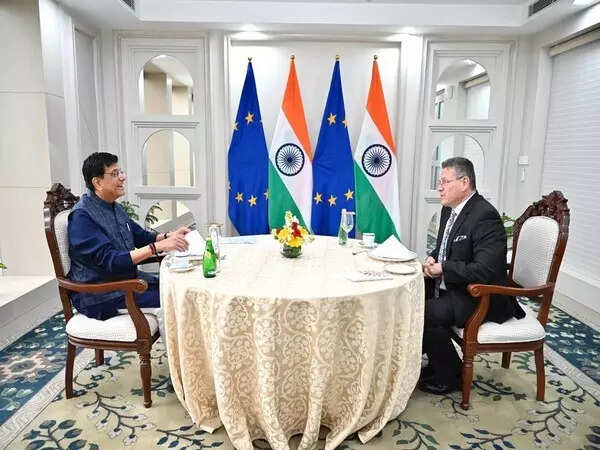- Blog
- 4 min read
India-EU economic ties: Strengthening trade, investment, strategic growth, future prospects
By proactively shaping investment-friendly policies, India can position itself as a more attractive foreign investment destination. Such initiatives will not only boost capital inflows but also support private and public investment, addressing current economic challenges.
Post-independence, India was among the first countries to establish formal relations with the EU (then the European Economic Community) to strengthen diplomatic and economic ties. As these relations deepened, discussions for a Free Trade Agreement (FTA) emerged in the early 2000s, aiming to enhance trade and investment by reducing tariffs, streamlining regulations, and expanding market access for goods and services.
However, negotiations stalled in 2013 due to key differences. Talks were revived in 2022, with both sides now working towards finalizing the agreement by the end of this year.
EU-India Trade and Investment: A Robust Partnership
Currently, the EU stands as India’s largest trading partner and a leading source of foreign investment, while India ranks as the EU’s ninth-largest trading partner. Foreign Direct Investment (FDI) from the EU to India has shown consistent growth, totaling USD 107.27 billion between April 2000 and December 2023.
Meanwhile, India’s Outward Direct Investment (ODI) to the EU amounted to USD 40.04 billion (April 2000 – March 2024). The European Investment Bank (EIB) has significantly contributed, investing over €3 billion in India’s infrastructure, energy, and climate projects, further solidifying the economic partnership.
Beyond Tariffs: Capital Flows and Investment Protection
While much of the discussion on the FTA has centered on tariffs and non-tariff barriers, a key outcome will likely be the increase in cross-border capital flows. The EU has the potential to become not only a major investment source but also a hub for technology transfer, provided that India’s regulatory framework facilitates this growth effectively. To ensure a stable investment climate, India and the EU are negotiating an Investment Protection framework that aims to prevent unfair treatment of investors, eliminate discrimination, and establish a robust dispute resolution mechanism.
The Trade & Technology Council (TTC), established in 2023, is another critical step in strengthening collaboration in research, digital technologies, and innovation-driven investment between the two regions. This initiative is expected to accelerate technological cooperation, attract investments, and create new business opportunities for both Indian and European enterprises.
Key Investment Trends and Sectoral Focus
Within the EU, the Netherlands, Germany, and Cyprus serve as major sources of FDI equity inflows into India, while Luxembourg, Ireland, and France hold significant shares in Foreign Portfolio Investments (FPIs). EU investments in India are concentrated in the automotive, technology, banking, and financial services sectors, with a growing focus on renewable energy, transportation, infrastructure, and urban development.
On the other hand, India’s ODI to the EU has fluctuated over time, with investments directed toward IT services, automotive, biotechnology, energy, and petrochemicals. The Netherlands, Belgium, Germany, and France have been key destinations for Indian investments. However, India's ODI to the EU remains significantly lower than EU’s FDI inflows into India. While India’s FDI outflows to the EU were higher than inflows in 2008, they declined in the aftermath of the global financial crisis. With the FTA in place, India’s ODI to the EU is expected to rise as new trade and investment opportunities emerge.
Collaboration in Green Energy and Infrastructure
India and the EU are actively collaborating on multiple sustainability initiatives, including smart cities, renewable energy, and climate resilience projects. Key programs such as the EU-India Green Hydrogen Partnership, EU-India Clean Energy and Climate Partnership, and the Global Green Bonds Initiative highlight a shared commitment to sustainable development. These collaborations are expected to drive substantial investments post-FTA, particularly in green energy and infrastructure.
The healthcare sector is another area of mutual interest. With India’s strong pharmaceutical industry and growing medical technology market, European investments are poised to expand in medical devices, biotechnology, and healthcare infrastructure. A key challenge, however, will be balancing innovation with affordability to ensure accessibility to essential medicines.
Looking Ahead: The Strategic Impact of the India-EU FTA
The India-EU FTA holds the potential to reshape trade and investment flows between the two regions. Beyond economic benefits, it is expected to generate positive spillover effects, including technology transfer, enhanced productivity, and strengthened economic resilience. However, for India to fully leverage these opportunities, key regulatory challenges—including labor market reforms, digital governance, taxation policies, and investment protection—must be addressed.
By proactively shaping investment-friendly policies, India can position itself as a more attractive foreign investment destination. Such initiatives will not only boost capital inflows but also support private and public investment, addressing current economic challenges. As India and the EU move closer to finalizing the FTA, the agreement could mark a significant turning point in their economic partnership, paving the way for sustained growth and mutual prosperity.
(The author is Associate Professor, Economics, IMI New Delhi; Views expressed are personal)








COMMENTS
All Comments
By commenting, you agree to the Prohibited Content Policy
PostBy commenting, you agree to the Prohibited Content Policy
Post